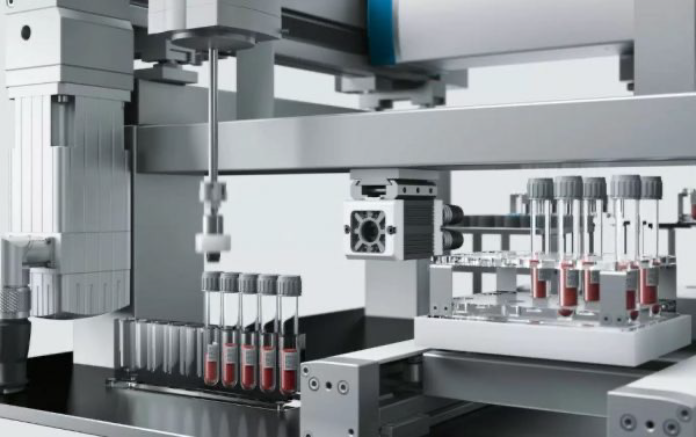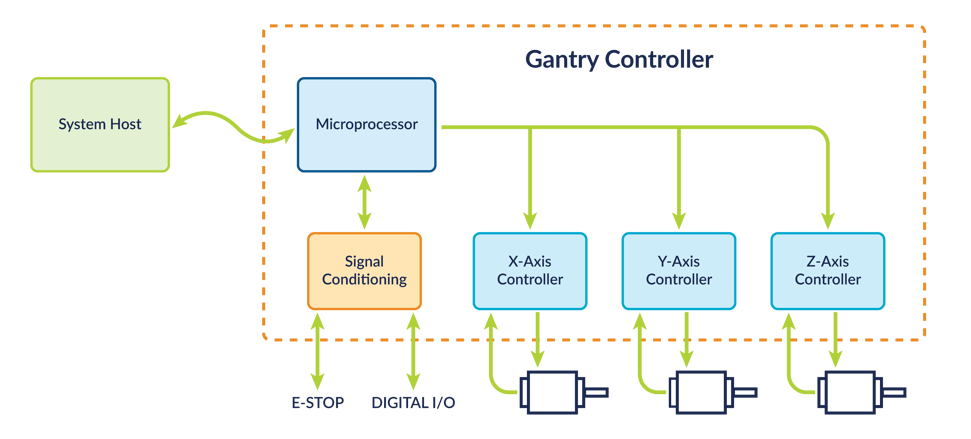Gantries are mechanical devices that move orthogonally in three dimensions. They form the basis of a wide variety of systems that process liquids, biological samples, industrial materials, and print, cut, or otherwise operate on materials. Gantry Control involves the synchronized control of motion functions such as point-to-point transfers, path following, pipette/cuvette management, and pick and place operation.
Operating gantries and the end effectors that they carry places special demands on motion controllers. Trajectory profiles must be designed to maximize throughput while minimizing the vibration injected into the mechanism. Furthermore, servo control techniques must operate safely over a wide range of payload weights and movement speeds. Most gantries use rotary motors with belts or pulleys to drive the mechanism, but linear Brushless DC motors are increasingly also being used.
One of the most important motion technologies associated with gantry control is S-curve profiling. A typical gantry makes a point to point move to a commanded position. A key consideration is injecting as little vibrational energy as possible into the mechanism during the move. Seven-segment s-curve profiles, which do not have acceleration discontinuities (unlike a trapezoidal profile, which instantaneously changes acceleration) achieve this and thereby allow faster moves with less settling time.

Another important motion technique used with gantries is acceleration feedforward. Acceleration feedforward is a position servo loop technique that minimizes the work that the position servo loop needs to do to provide the highest tracking accuracy, particularly during acceleration and deceleration trajectory phases. Note that if step motors are used to drive the gantry feedforward techniques do not apply.
Another motion technique that can be very important for gantry control is motion error detection. This is typically achieved by continuously comparing the position servo loop desired position command with the actual encoder position. If a programmable threshold is exceeded due to a blockage the motion controller automatically shuts down motion, thereby protecting the gantry mechanism and possibly the load.
Almost all gantry-based system carry some sort of actuator, applicator, tool, or sensor at the end of the moving axes system. For lab automation this is often a device that dispenses and aspirates liquids. For other types of machines that use a gantry this may be a gripper, a touch sensor, a material dispenser, a camera, a cutting device, a robotic arm, and more. There are a nearly endless variety of systems that use a gantry mechanism to achieve their intended operating purpose.
The diagram below shows a typical (although simplified) control architecture for an embedded gantry controller. A system host sends high level commands such as “deliver the object to XYZ station #7”. The controller, which has three axes of positioning motion control, receives these high level commands and parses out the low level motion sequences to each axis needed to complete the overall function.

Since 1992 Performance Motion Devices products have been used to control wide range of gantry-based systems including blood analyzers, DNA sequencers, 3-D printers, packing equipment, cutters, and much more. Our Magellan Motion Control ICs, ION Drives, and Prodigy Motion Control Boards all provide the vital motion control technologies needed to successfully build your gantry controller application.
PERFORMANCE MOTION DEVICES, INC.
80 Central Street | Boxborough, MA 01719
P: 978.266.1210 | F: 978.266.1211 | info@pmdcorp.com